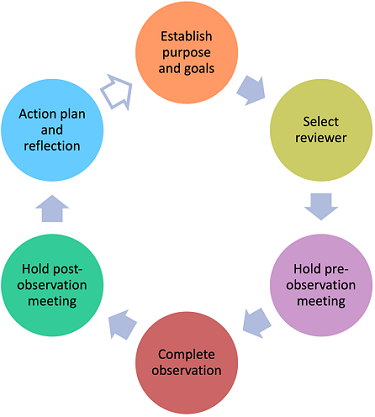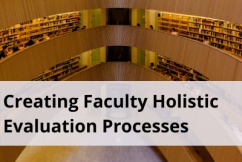Evidence from Peers
Gathering feedback on teaching from peers is an essential practice for the development of teaching skills and exploration of pedagogical possibilities. Evidence from peers may include peer review of teaching and teaching materials, invitations from peers to present on teaching and learning, teaching awards received from peers, and other formal and informal feedback.
Peer Review
What is it?
Though often associated with peer observation of classroom teaching, peer review encompasses a variety of practices aimed at promoting development of teaching among colleagues. Speaking to this variety represented across the literature, and the non-prescriptive flexibility within the policy's statement on peer review, we offer this definition: Peer review is the purposeful presentation of one or several "pedagogical objects" or interactions (Esterhazy, de Lange, Bastiansen & Wittek, 2021) to an appropriate reviewer(s) in order to receive feedback, or catalyze reflection, as part of a collective effort to enhance teaching. Pedagogical objects and interactions might include: classroom observation, online discussion board observation, review of teaching materials and artifacts (such as syllabi, rubrics, learning outcomes or communications), review of online course sites, interviews with students, and evidence of peer mentorship.
Formative peer review of teaching process should be conducted in a systematic, transparent, and collegial manner that is mutually agreed upon by reviewer and reviewee. Evaluative peer review of teaching processes should ideally be conducted in a similar manner, but Faculties may provide some guidelines or direction in this context. In either case, the intent is to offer relevant and targeted feedback, based on the reviewee’s goals. Ideally, this process is cyclical, taking opportunities to question, reflect on and refine teaching practices at regular intervals. (Chism, 2007; Courneya, Pratt & Collins, 2008).
Why do it?
Like research, teaching benefits from peer review by providing practitioners opportunities to practice in the open—examining pedagogical technique and exploring alternatives (Bandy, 2015). It can give both reviewee and reviewer confidence in existing practices while also encouraging interest in and motivation to engage in different practices and perspectives (Hendry, Bell & Thomson, 2014; Thomas, Chie, Abraham, Jalarajan Raj & Beh, 2014; Esterhazy et al., 2021). It may also facilitate the bubbling up of shared goals and joint projects among departmental or cross-departmental colleagues as communicative spaces (Barnard, Nash, McEvoy, Shannon, Waters, Rochester & Bolt, 2015). In other words, it can be beneficial not only to the person being reviewed, but to the reviewer as well.
Engaging in peer review and discussing your teaching with colleagues can also impact the ways in which we work and contribute to the teaching and learning community in our own departments. For example, it can help alleviate the isolation some instructors feel, as it tends to lay bare the social contexts and teaching challenges within them, and it can also help groups "make sense" of complex situations (Peel, 2005 in Esterhazy, et al., 2021; Swinglehurst, Russell & Greenhalgh, 2008).
Peer review models, processes and examples
While the policy “requires the formal peer review of teaching”, peer review is not necessarily summative or comparative in its evaluative practices—formative evaluation is as helpful in producing evidence of teaching effectiveness, and, what is more, is more likely to produce genuine engagement with the process, encourage actual integration of feedback into teaching practices, and produce demonstrable professional development growth over time (Hendry, et al., 2014; Esterhazy, et al., 2021).
A formative model of evaluation, contrasted with summative evaluations undertaken for official processes of hiring, reappointment, tenure or promotion, is done with the aim to provide a peer, or oneself through the observation of a peer, a structured space in which to discuss pedagogical issues and problems, explore options and reflect on practices—a space in which to trial-and-error teaching approaches. Formative models often include a developmental aspect that prioritizes the professional development of the instructor over time. They provide participants opportunities, at regular intervals, to reflect on reviews or observations, implement changes, and then undergo review or observation again. Within a formative and developmental model of peer review of teaching (objects or interactions), peers discuss what they want to get out of the process, agree on how the aspect of teaching under review will be observed and evaluated, reflect on the feedback to create an action plan, and execute that plan at some future date. The process can then start again.

A formative and developmental model—the circle doesn't close after "action plan". This model may be applied to any pedagogical object under review by a peer. The diagram shows the six steps of an iterative cycle in the clockwise order: establish purpose and goals, select reviewer, hold pre-observation meeting, compete observation, hold pos-observation meeting, action plan and reflection.
A great variety of examples can proceed within this model. Some example scenarios include:
- A pair of instructors (within a department, from different departments, or a junior and senior colleague, together) might reciprocate classroom observations or reviews of student feedback data.
- An instructor trio might share video-recorded segments of their teaching and then apply a group-created rubric to assess the segments; or, use the recorded segments as catalyst for making personal observations on one's own teaching, discussing similarities and differences, thereby taking an "observational learning" approach (Hendry, Bell & Thomson, 2014; Warren 2021) or a "reflective peer coaching" approach (Vidmar, 2006). CLT's own Faculty Certificate in Teaching and Learning has registrants engage in three formative peer review cycles for one component of the certificate.
- A larger group of instructors might engage in discussion and reflection circles that happen at regular intervals throughout an academic year, directing discussion around one topic, making an experimental change in their courses, and then reflecting on results together (Quinlan & Ă…kerlind, 2000; Swinglehurst, et al., 2008).
As you consider what peer review processes might work for you or for your department/Faculty, inspiration may be gained from our peers including: the University of Calgary's guide on the method, The University of Melbourne , the University of Adelaide's "", and the University College Dublin for an equitable observation process.
Considerations for implementing formal peer review processes
There are things to consider at both the personal and departmental/Faculty level when implementing a formal peer review process. The review process takes time and energy for both parties. Training may also be necessary for those who have not engaged in peer review before or who are new to a Faculty's process and expectations. Following up on feedback and making changes to teaching can prove difficult, if making time for such things is not explicitly approved of nor encouraged by departments. An atmosphere of trust and non-competitiveness produces the most useful and genuine results, and therefore is less effective in workplace cultures that lack practices of giving constructive feedback and peer support. Gaining faculty buy-in can also be difficult due to pre-existing attitudes on teaching and the scholarship of teaching and learning and it’s value in relation to research productivity. Managerial, “quality assurance”-type frameworks, or processes that overemphasize being observed, produce anxiety rather than teaching development and collegiality (Swinglehurst, et al., 2008).
Additionally, successful implementation and uptake of a peer review process depends on the context of each Faculty and the disciplines therein. There is no one right model for peer review, and disciplinary cultures may influence the success of one over another. In a study comparing two departmental peer review initiatives, authors Quinlan and Ă…kerlind (2000) found that faculty in disciplines holding a high degree of agreement around epistemological and pedagogical issues were more receptive to teaching development initiatives among peers. However, this does not mean that some will be more successful than others in their peer review processes. If Faculties offer space and time for instructors to explore their fundamental beliefs about teaching and learning (Hubball & Clarke, 2011) while acknowledging contexts, cultures and circumstances, a right fit can be found.
Despite its challenges, peer review of teaching can be enormously rewarding, beneficial for professional and personal development, and can enhance the student experience.
Useful guides for reviewers and reviewees
The following have been developed to help guide you as you engage in a peer review process.
Other forms of Evidence from Peers
Evidence from peers may also be collected beyond departmental peer review activities. Some examples include:
- Letters and Invitations from Peers: Letters of reference from peers recognizing your contributions to teaching and learning can provide insight into and draw attention to specific parts of your work. These letters may be from peers internal or external to your department and/or institution. They may come from a teaching mentor, a chair of a teaching initiative to which you contribute, a co-supervisor who can speak to your mentorship of students, or colleagues who can speak to your coordination of multi-section or team-taught courses. Peers and former supervisors may also speak to the impact of your co-teaching/mentorship/collaboration on their own teaching practices, departmental culture of teaching and learning, and preparation of students for future courses. Invitations from peers (internal and/or external) to participate in teaching and learning events also reflect how your peers value your approaches and expertise. Invitations to sit on institutional or external committees related to teaching and learning and to present at teaching and learning conferences are two such examples.
- Community Impact: How your teaching practices and contributions extend to the broader teaching and learning community can be another form of evidence from peers. Authorship of widely-used textbooks/learning materials/teaching methods, authorship of highly-cited publications in teaching and learning, and significant uptake of a teaching resource you created (e.g. a website or repository of teaching objects) are only some examples of how peers demonstrate the value of your contributions. Letters from community members who can describe how your partnership affected teaching and learning within community programs is another way source of evidence.
- Teaching Awards/Grants/Fellowships: Recognition of your work through teaching awards (including nominations) and grants by your peers are evidence of how others see the positive impact of your work. These may be from your department, faculty, institution, or external (e.g., via a professional association or national/international teaching award committee). Visit our Awards and Grants page for information on university-wide teaching awards, teaching and learning grants and regional and national awards.
References
Alabi, J., & Weare, J., William. (2014). Peer Review of Teaching: Best Practices for a Non-Programmatic Approach. Communications in Information Literacy, 8(2), 180–191.
Bandy, J. (2015). Peer Review of Teaching. Vanderbilt University Center for Teaching. Retrieved January 11, 2021 from
Barnard, A., Nash, R., McEvoy, K., Shannon, S., Waters, C., Rochester, S., & Bolt, S. (2015). LeaD-In: A cultural change model for peer review of teaching in higher education. Higher Education Research and Development, 34(1), 30–44.
Bennett, S., & Barp, D. (2008). Peer observation – a case for doing it online. Teaching in Higher Education, 13(5), 559–570.
Chism, N. V. N. (2007). Peer review of teaching: A sourcebook (2nd ed.). Bolton, Mass.: Anker Pub. Co.
Courneya, C.-A., Pratt, D. D., & Collins, J. (2008). Through what perspective do we judge the teaching of peers? Teaching and Teacher Education, 24(1), 69–79.
Esterhazy, R., de Lange, T., Bastiansen, S., & Wittek, A. L. (2021). Moving Beyond Peer Review of Teaching: A Conceptual Framework for Collegial Faculty Development. Review of Educational Research, 91(2), 237–271.
Hendry, G. D., Bell, A., & Thomson, K. (2014). Learning by observing a peer’s teaching situation. The International Journal for Academic Development, 19(4), 318–329.
Hubball, H., & Clarke, A. (2011). Scholarly approaches to peer-review of teaching. Transformative Dialogues: Teaching and Learning Journal, 4(3).
Marshall, B. (2004). Learning from the Academy: From Peer Observation of Teaching to Peer Enhancement of Learning and Teaching. Journal of Adult Theological Education, 1(2), 185–204.
Thomas, S., Chie, Q. T., Abraham, M., Jalarajan Raj, S., & Beh, L.-S. (2014). A Qualitative Review of Literature on Peer Review of Teaching in Higher Education: An Application of the SWOT Framework. Review of Educational Research, 84(1), 112–159.
Peel, D. (2005). Peer observation as a transformatory tool? Teaching in Higher Education, 10(4),&˛Ô˛ú˛ő±č;489–504.&˛Ô˛ú˛ő±č;
Quinlan, K. M., & Åkerlind, G. S. (2000). Factors Affecting Departmental Peer Collaboration for Faculty Development: Two Cases in Context. Higher Education, 40(1), 23–52.
Swinglehurst, D., Russell, J., & Greenhalgh, T. (2008). Peer observation of teaching in the online environment: An action research approach. Journal of Computer Assisted Learning, 24(5), 383–393.
Vega GarcĂa, S. A., Stacy-Bates, K. K., Alger, J., & Marupova, R. (2017). Peer Evaluation of Teaching in an Online Information Literacy Course. Portal (Baltimore, Md.), 17(3), 471–483.
Vidmar, D. J. (2005). Reflective peer coaching: Crafting collaborative self-assessment in teaching. Research Strategies, 20(3), 135–148.
Warren, F. (2021). Diffracting peer observation: Talking about differences, not looking for perfection. The International Journal for Academic Development, 1–5.

